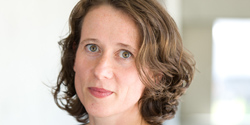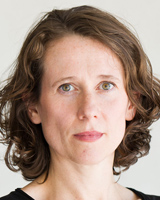Dance of the Chromosomes
Biologist Sylvia Erhardt examines how chromosomes can be correctly assigned to the daughter cells during cell division and how an inconspicuously small chromosomal constriction affects this process.
Every day, countless small miracles occur in our body: a cell divides and passes all its skills on to the two newly created cells. The structures that ensure the equal distribution of a cell's genetic material to the two daughter cells are called centromeres. They are the peculiar little constrictions that form on the chromosomes, the carriers of genetic information, during cell division. While the centromeres may look insignificant, they fulfil an essential function: just as there would be no Magic Flute without Mozart so there would be no cell division without centromeres - no new cells to replace old ones or to create a complete organism during embryonic development.

As a member of the “Cellular Networks” Cluster of Excellence at the Center for Molecular Biology of Heidelberg University (ZMBH), biologist Sylvia Erhardt investigates how this mysterious chromosome region works and what role defective centromeres play in the development of diseases such as cancer or congenital defects. “Science is not for lone wolves”, she states. “Here in Heidelberg, Cellular Networks offers me an excellent platform for interdisciplinary exchange along with everything else I need for good research.”
“The centromere is a kind of anchor”, says Erhardt in order to explain the complex function of the small constrictions that she examines every day. In a chromosome that is ready to divide, a special structure consisting of many different proteins - the kinetochore - forms at this anchor. This is where the fibres of the spindle apparatus attach themselves. A look into the microscope shows how the spindle fibres “grab” the chromosomes at the kinetochore and position them at the cell's centre line during cell division. A little later, the chromosomes have divided and are pulled apart by the spindle fibres. Then the cell cuts itself in half: one cell has become two.
“If the kinetochore doesn't function as it should, the daughter cells are assigned too few or too many chromosomes”, explains Sylvia Erhardt. Such “chromosomal anomalies” are typical for cancer cells. A better understanding of the functioning of the region that is responsible for the correct distribution of chromosomes might provide valuable leads for a targeted and improved cancer therapy.
Sylvia Erhardt is especially interested in the epigenetic influences that ensure the formation of fully functional centromeres. Epigenetic influences (the Greek prefix “epi"means “over” or “above”) are mechanisms and factors that affect inheritance on a superordinate level to DNA. Among these factors are the histones - proteins which scientists used to believe were only the packaging of the DNA. Today, they know that histones are much more: they help decide which genes are copied and translated into proteins. One histone variant called “CENP-A” (centromere protein A) only occurs in the centromere region of chromosomes: “Without this specific histone”, explains Sylvia Erhardt, “the kinetochore, the contact point for the spindle fibres, can't develop.”
And there are still many unanswered questions about this remarkable histone variant. Sylvia Erhardt and her colleagues have undertaken to investigate the centromere and its epigenetic regulation and to find out in detail how chromosomes are assigned their new place during the cell division process. The choreography of chromosome segregation is as fascinating as it is mysterious. “The more you learn”, says Sylvia Erhardt, “the more exciting it gets.”
Short Biography
Dr. Sylvia Erhardt
 Sylvia Erhardt studied biology in Heidelberg. Impressed with the then young research field of epigenetics, she joined the Heidelberg work group of Renato Paro, a pioneer of epigenetics research, for her diploma thesis. After working as a researcher in Cambridge, England, and Berkeley, USA, Erhardt returned to Heidelberg in late 2007, together with her husband Aubry Miller and their daughter. Erhardt became head of a junior research group in the “Cellular Networks” Cluster of Excellence, and Aubry Miller found a position as chemist at the German Cancer Research Center (DKFZ) with the help of CellNetworks and the ZMBH. “Without this job offer for my husband, we wouldn't have come back to Heidelberg”, says the mother-of-two.
Sylvia Erhardt studied biology in Heidelberg. Impressed with the then young research field of epigenetics, she joined the Heidelberg work group of Renato Paro, a pioneer of epigenetics research, for her diploma thesis. After working as a researcher in Cambridge, England, and Berkeley, USA, Erhardt returned to Heidelberg in late 2007, together with her husband Aubry Miller and their daughter. Erhardt became head of a junior research group in the “Cellular Networks” Cluster of Excellence, and Aubry Miller found a position as chemist at the German Cancer Research Center (DKFZ) with the help of CellNetworks and the ZMBH. “Without this job offer for my husband, we wouldn't have come back to Heidelberg”, says the mother-of-two.

